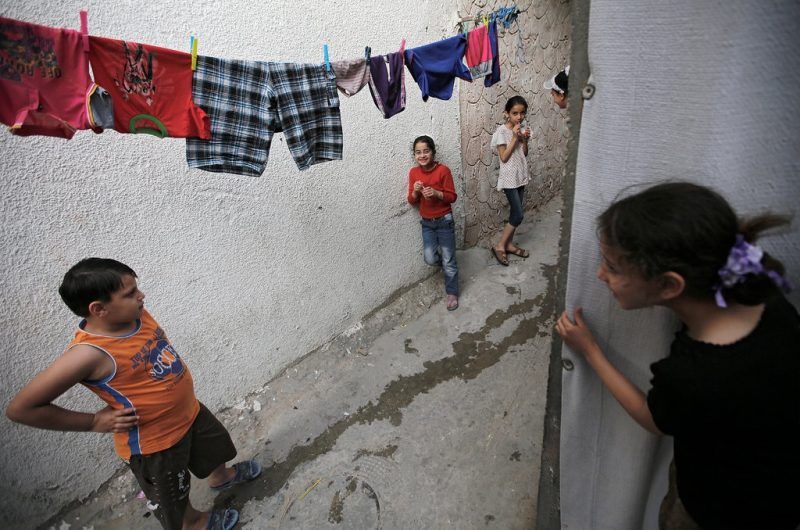
Balloons emblazoned with an Olympic-style torch bobbed cheerfully in the sky above a swimming meet. For 12-year-old Adam Nairab and the other children on the beach, they provided inspiration. The balloons meant there was more to life than drones, explosions and the threat of sudden death.
Sports and art classes at the United Nations-sponsored school offered these Gaza kids a semblance of normalcy and an outlet for expression. For two summers, Adam loved going to summer camp. It was a rare chance to play and learn in a carefree environment.
But the balloons, swimming races and classes are yesterday’s opportunities, just out-of-reach memories. Thanks to a funding crisis, many of the pleasures of summer camp have been canceled. Life for Gaza’s kids is back to a dreary monotony of having too little to eat and too little to do, in a territory that’s without electricity for 18 hours a day.
Starting in 2007, the United Nations Relief and Works Agency — the leading provider of services to refugees in the Gaza Strip — offered recreational and educational summer programs to more than a quarter-million children. Thousands more have benefited from similar efforts by Unicef.
Traumatized by wars, living under siege without basic amenities, the children had little to look forward to besides the “summer fun weeks” sponsored by Unicef and the relief agency. Camp was one of the few times in their lives they could simply be children.
“This is extremely important in Gaza, where children live in a difficult environment, experiencing high levels of stress with detrimental impact on their studies,” June Kunugi, a senior Unicef official, told me. “They are often unable to attend extracurricular activities due to overcrowding in the classroom, and schools operating in double shifts.”
Since the devastation inflicted by the 2014 conflict, the privations of Gaza’s schoolchildren have grown worse. In winter, thousands of those left homeless by war freeze in temporary shelters; in summer, these same shelters become stiflingly hot. For a few weeks, summer camp gave some respite from all that.
The pinched assistance that the relief agency provides is being further undercut by the cost of adhering to the extensive Israeli security requirements for importing supplies. These measures cost the agency $8.6 million last year — enough money to build six schools or to feed nearly a million refugees for five weeks.
This year, the donor states cut their funding for the summer programs. There will be no drama, no swimming, no sand castle building, no volleyball, no football, no painting, no origami.
The children of Gaza who in 2011 recorded a world record for the most kites flown at one time, over 10,000, won’t get the chance to beat that. Starting in July, only about 125,000 children will attend camps, half as many as participated in previous years.
The international donors’ obligation to help Palestinians has not gone away. Is the future of these children, who make up about half the population of Gaza, not worth investing in? Not only do the camp sessions provide girls and boys equal opportunities to play, but they also seek to teach new skills in a stifled economy where good jobs are scarce, as well as instill coping mechanisms for Gaza’s extremely stressful environment.
“The streets are unsafe for play,” Adam told me. “Walking by the border is too risky, as flying bullets from the Egyptians could hit anyone walking by.”
Rather than look forward to summer, he’s now dreading it. His only option is to attend a program run by one of the many political factions in Gaza and be steeped in ideological thinking. The absence of international donor programs has left a vacuum. The Hamas movement just announced that it is opening registration for a summer camp of its own.
The choice for most parents will be between whatever programs Hamas offers or sending their children off to play in one of the old refugee camps established here after Palestinians, including Adam’s family, were driven from their land and villages when Israel was founded in 1948. Adam’s mother, Safa’a, is as frustrated as he is.
She said she had doubts about sending any of her five children to such camps. “But, if nothing else is left,” she said, “people will send their kids, because there is nowhere else.”
Adam’s father, Fareed, who is unemployed and relies on United Nations handouts to feed his family, can’t do much about it. His situation is symptomatic of a wider malaise. The lack of opportunity, stress and sense of futility have contributed to a soaring rate of suicides among young men, up 35 percent to 40 percent in the first few months of 2016, compared with the same period in previous years.
At least the relief agencies’ summer programs had provided prized summer jobs for recent university graduates, including college-educated women. Last year, there were about 34,000 applicants for 2,200 positions as teachers and mentors. The shrinking options for young women mean that more and more must choose marriage rather than a career. Above all, it is the siege of Gaza, now entering its 10th year, that makes thousands of our young people idle and restricts their choices.
American and French peace initiatives have been blocked by the intransigence of Prime Minister Benjamin Netanyahu and the Israeli government. Yet, even without the will to secure Palestinian freedom, there is still something the international community can do: provide hope.
Fund the programs that allow these children to forget, for a few hours, that they are refugees in their own land. Show them that there is an alternative to factionalism and fighting.
To donor states, summer activities may seem a trivial footnote. For the children of Gaza, though, they offer a lifeline to a different future.
Mohammed Omer, a journalist, is the author of Shell-Shocked: On the Ground Under Israel’s Gaza Assault.
